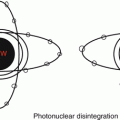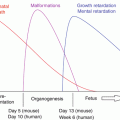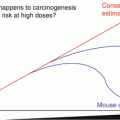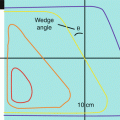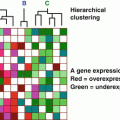, Foster D. Lasley2, Indra J. Das2, Marc S. Mendonca2 and Joseph R. Dynlacht2
(1)
Department of Radiation Oncology, CHRISTUS St. Patrick Regional Cancer Center, Lake Charles, LA, USA
(2)
Department of Radiation Oncology, Indiana University School of Medicine, Indianapolis, IN, USA
Definition of Range
Particulate radiation has a finite range which is approximately how far they can travel in a medium before stopping.
For our purposes, whenever we say range we mean RCSDA, range defined by the continuous slowing down approximation (CSDA).
Types of Particulate Radiation
Charged and Uncharged Particles
Charged particles can directly interact with electrons and nuclei, through coulombic interactions. Therefore they are “directly ionizing” and are generally less penetrating than uncharged particles.
Uncharged particles cannot interact through coulombic forces so they are indirectly ionizing. Heavy uncharged particles are more likely to interact with nuclei than with electrons, and they are relatively more penetrating.
Light and Heavy Particles
“Light” particles are particles with a mass similar to electrons (basically just electrons and positrons).
Due to their mass, they change directions (scatter) very easily.
Path length is much longer than range! (Fig. 5.1).

Fig. 5.1
Path length vs range: electrons usually have a tortuous path, thus path length is always greater than range.
“Heavy” particles are significantly heavier than electrons, basically everything else. For example, a proton has ~1,800× the mass of an electron.
Due to their mass, they travel in a nearly-straight line.
Path length is roughly equal to range.
How Do Charged Particles Interact?
Unlike photons, charged particles are directly ionizing.
Charged particles have a variable velocity, unlike photons which always move at the speed of light.
Velocity and energy are directly related to each other; when a particle gains energy it moves faster.
Particles gradually lose energy as they interact with the medium.
This is in contrast to photons which undergo attenuation: decreasing the number of photons in the beam, without changing the energy of the individual photons (Fig. 5.2).
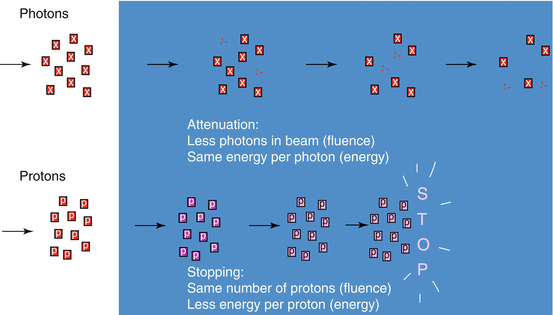
Fig. 5.2
Attenuation vs stopping power: Indirectly ionizing particles (photons) will undergo multiple scatterings and collisions in a random fashion that will decrease the number of photons (fluence – see Chapt. 6). Protons and other particles will have paths that decrease in energy as they interact with more atoms through coulombic force but gradually they will slow down and eventually come to a stop with some degree of certainty for a given starting energy. Think of stopping power as the amount of power it takes to stop Mr. Particle (see Fig. 5.3).
Two basic types of collisions:
Elastic Collisions: think of a game of pool.
Kinetic energy and momentum are both conserved; energy is transferred between the particle and the medium.
All of the energy is kept in the form of motion.
Inelastic Collisions: think of a bullet going through a wall.
Kinetic energy and momentum are not conserved; the particle transfers energy to the medium and slows down.
This energy may be released as a photon, or it may be transferred to an electron (causing ionization).
Charged Particle Specifications
The W value is the average energy needed to produce an ion pair in a gas.
For example, in dry air at standard temperature and pressure, W is approximately 33.97 eV.
W is very small compared to the typical energy of charged particles (a few MeV for electrons, hundreds of MeV for heavier particles). Each particle makes a lot of ions!
Specific ionization is the number of ion pairs produced per unit path length.
Specific ionization is higher at low energies, and lower at high energies.
This is because a high energy particle moves too fast to have time to interact with surrounding materials.
Linear energy transfer (LET) and Stopping Power are closely related concepts that measure the energy transfer between a charged particle and the medium.
Stopping Power is the amount of energy the particle loses per unit path length; think of it as the amount of “drag” on the particle.
LET is the amount of energy that the particle deposits in local ionizations per unit path length. Think of it as the amount of damage a particle leaves in its track.
Specific ionization, Stopping Power and LET all increase as a particle slows down. This is because it has more time to interact with the medium (Fig. 5.3).

Fig. 5.3
Particle energy and LET: Mr. Particle is a mean dude but if he is traveling too fast, he can really only throw passing insults at electrons. If he slows down or even stops, all hell breaks loose!
Linear Energy Transfer Relationships
LET is a measure of the interaction between a particle and a medium.
LET increases with the particle’s charge (Q):
Approximately proportional to Q 2 .
Ex: A 10 MeV carbon ion (Q = +6) has a LET of 200 keV/μm, while a 10 MeV proton (Q = +1) has a LET of 4 keV/μm.
LET decreases with the particle’s velocity (V):
Approximately inversely proportional to V 2 .
At energies much lower than the particle’s rest mass (mc 2 ), V 2 is proportional to Energy
Stay updated, free articles. Join our Telegram channel

Full access? Get Clinical Tree



